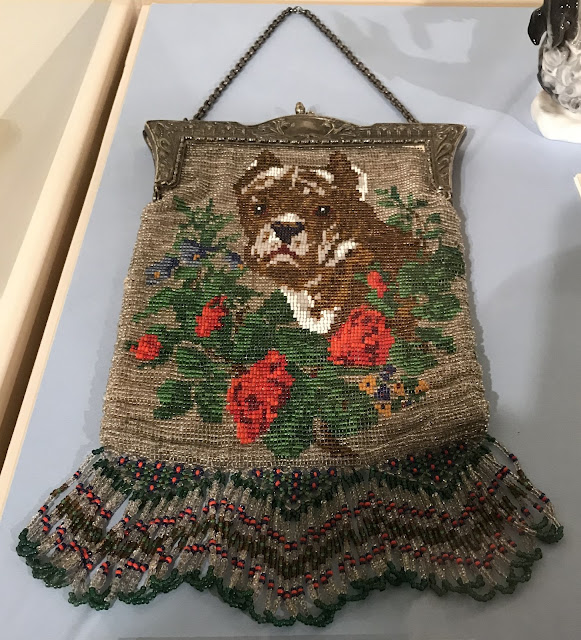St. Louis, MO 63110
Admission to museum and parking are free. Sometimes admission fees for a special exhibit.
http://www.slam.org/
Founded in 1881.
This art museum began in 1881 in downtown St. Louis and was associated with Washington University. After the 1904 World's Fair, also known as the Louisiana Purchase Exposition, the museum moved to the Palace of Fine Arts, built for the fair from 1902 to 1903. This building is the only permanent structure built for the Fair. In 2013 a large expansion project was completed.
The museum sits in Forest Park. The view from the Art Museum down Art Hill to the Emerson Grand Basin, refurbished about ten years ago, is a favorite view in the park.
The lobby
Beautiful galleries
Our main goal in visiting this very large museum was to visit a special exhibit of a work by the daughter of one of our museum muses.
Amy's original work was on exhibit at the Whitney in NYC before being purchased by a Swiss collector. It consisted of three 16mm projectors. This was a digital copy of that original project. It was projected on a wall in a small private gallery on an upper floor of the museum.
We were so honored to have the artist, Amy, join us to talk about this work. After having lived in NYC, LA, and Europe, Amy has returned to St. Louis where she co-owns Parapet Real Humans, an art space in the city. Amy continues to create projects and show her work in NYC, Europe, and elsewhere.
Following our private viewing we joined Amy and her mother for lunch at Panorama, one of two restaurants in the Art Museum.
The menu was great and the food was wonderful.
Grilled Eggplant Napoleon - Ozark Forest Mushrooms, roasted red peppers, goat-cheese, basil-mint oil
Rocket Salad - Duck confit, mission figs, blue cheese, extra-virgin olive oil, Champagne vinegarWarm Proscuitto - brie, arugula, tomatoes, bacon jam with caramelized cauliflower with toasted almond and honey drizzle
The Art Museum is known for its wonderful gift shops. In addition to the gift shop shown below there is one in the new contemporary wing.
The collection of the Saint Louis Art Museum contains more than 30,000 art works dating from antiquity to the present and is divided into eleven areas. As many as a half million visitors visit the museum each year. Below is some of the art pieces found in the museum currently. I photographed these items just to share the wide variety of artworks found in the museum. In reality, there are many many paintings in the galleries, but only two shown below. These works are in no particular order.
St. Christopher, last quarter 15th century, French, Burgundian or Flemish, limestone.
Madonna and Child Enthroned with Saints Christopher, Blaise, Sebastian, and Francis, c.1410-1412, Lorenzo di Nicollo, Italian, tempera and gold leaf on panel
Octagonal Jar with Design of Cherry Trees, Peonies, and Chrysanthemums, early 18th century, Japanese, Arita ware
Siva Nataraja, 12th century, Indian, bronze and iron and two similar pieces
Shell Applique, 1991, Koike Shoko, Japan, stoneware with clay and with metallic glaze
Box with Design of Auspicious Animals, Plants, and Flowers, late 18th-early 19th century, Korean, painted ox horn and lacquer on wood with brass fittings
Bactrian Camel, 8th century, Chinese, earthenware with lead-fluxed glazes over white slip
Votive Stela of Sakyamuni Buddha and Attendant Bodhisattvas, 505, Chinese, limestone with gesso and traces of pigment
Breaking of the Vessels, 1990, Anselem Kiefer, German, lead, iron, glass, copper wire, charcoal, and Aquatec
Basin, mid-14th century, Egypt, brass with silver and gold inlay
Genius of America, 1858, Adolpjhe Yvon, France, oil on canvas
Fragment of Floor Mosaic from the upper level of the House of the Bird Rinceau, room 1, Antioch, Syria, c. 526-540, Byzantine, marble and limestone
Votives and Personal Religion
Burning Rods, 1984-87, Anselm Kiefer, Germany, oil, acrylic emulsion, and shellac on canvas with lead, copper wire, straw, iron, and ceramic
Fragment of a Sarcophagus, 2nd century, Rome, marble
Acrobat on Trapeze, 1940, Max Beckmann, Germany, 1940
Amor Caritas, 1898, Augustus Saint-Gaudens, Ireland, bronze
A. Y. O. R. (At Your Own Risk) Chair, 1990, Ron Arad, Israel, stainless steel and lead
Butterfly or Hawk Mask, early 20th century, Bwa, wood, paint, fiber
Chair, c. 1820, Austria, multiple woods and reproduction silk upholstery
Dish with Handle in the Form of a Bird, 1476-1534, Inca, ceramic with pigment
Head from a Figure, 600-909, Maya, stucco with pigment
Maretta Mizimimah II, 2004, Toots Zynsky, USA, glass threads
Portrait of a Woman, 1873, Edmonia Lewis, marble
Seated Figure, c. 900-300 BC, Olmec, ceramic with pigment
Tapestry Panel, Christ Bearing the Cross, Belgium
Comments: The St. Louis Art Museum is a well-loved destination in St. Louis. It is free. It is in beautiful Forest Park. It is well-organized with a huge variety of art works. It has wonderful special exhibits. It has great gift shops. And great restaurants.
All of us had been here many times and will return many more times. The museum is way too large to really see everything in one visit and since it is free, one can easily return time and again to see more art works.
I highly recommend studying the website before going to see what the museum offers.
We loved being with the artist and learning how her work came about. Thank you, Amy, for sharing your talent and your time.
And the restaurant was great. The view was beautiful, the menu interesting, and the food delicious.















































































































